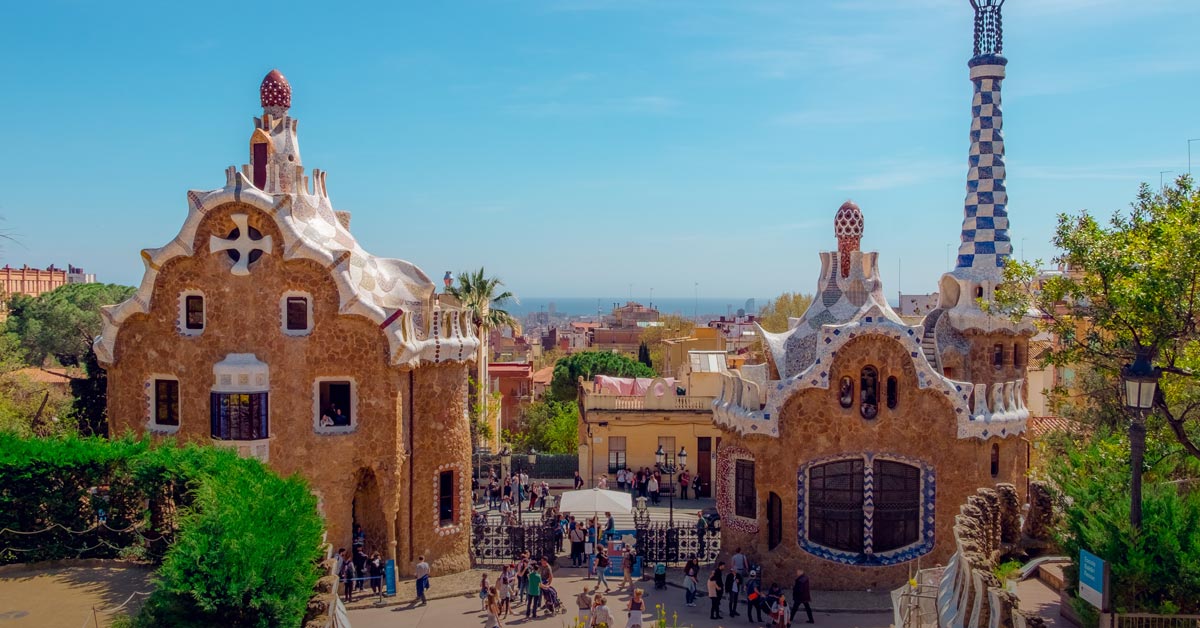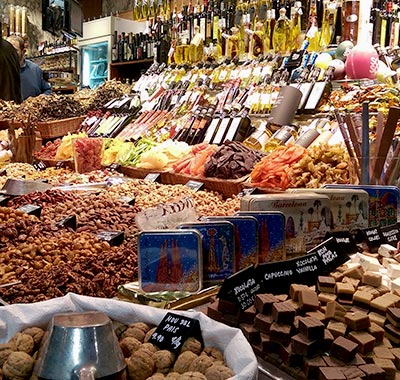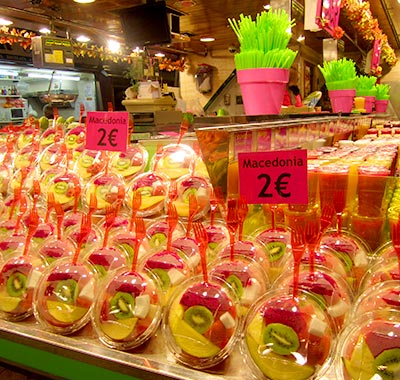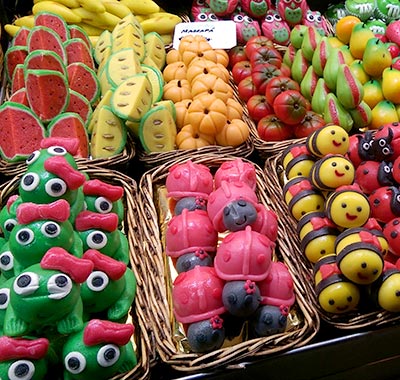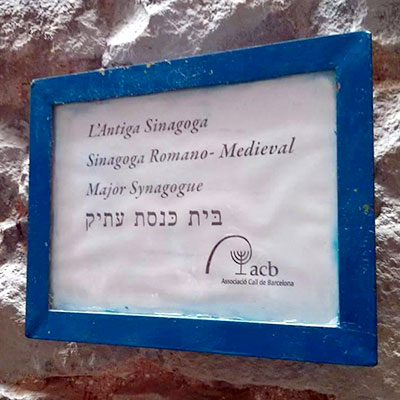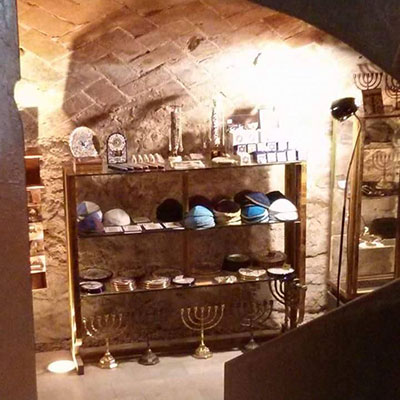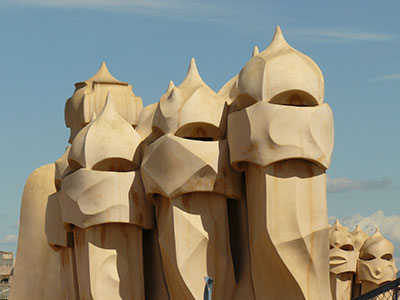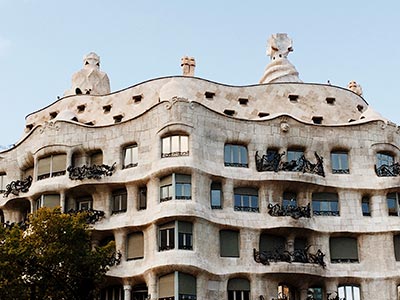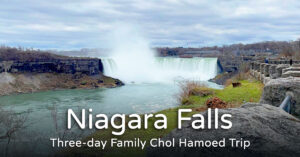Barcelona is nicknamed Gaudí’s city, the artists that, more than any other, has left his mark on it. Throughout the city one can see his unique characteristic motifs: colorful ceramic pieces, amorphous shapes, and long pointy arches.
Architects, artists and designers worldwide flock to Barcelona to get a close view of Gaudí’s fantastic creations, and enjoy art by Picasso, Juan Miró , Dali, and more along the way.
Day 1
We begin our day touring the rich and colorful La Boqueria market. From there we continue to the Gothic Quarter, where we will view the Ancient Synagogue of Barcelona on El Call Alley. We will also visit the El Call Museum, which depicts the glorious past of the Barcelona congregation and the Rashba, and if we’re not too tired and have some time left, we will go to the Barcelona City History Museum.
We will lunch at Parc de la Ciutadella- a perfect place for an outdoor picnic- and tour the large triumphal arch at the park’s outskirts.
Afternoon we will go to the Old Harbor, Port Vell, visit the Aquarium Barcelona, considered to be one of the best in the world, and enjoy the romantic view of Barcelona at sunset…
La Boqueria Market
La Boqueria Market is known as one of the best food markets in the world. It is a large and colourful market, with an entrance from La Rambla Street. The market is a display window for the city’s overwhelming variety of foods; fresh fish from the harbor, exotic fruits and vegetables, dry-goods, sweets, and more.
The market’s stalls are well kept and gleaming (just Machne Yehuda style ![]() ) and offer quality goods.
) and offer quality goods.
Tip: The market has freshly squeezed juices for sale, as well as stalls with pre-cut fruits and vegetables in clear plastic containers which include utensils—perfect for those who keep kosher!
The market is open Monday-Friday, from 8:00AM to 8:30PM. It is recommended to come in the morning or around noon, since many of the stalls close in the afternoon hours.
The Gothic Quarter
The Gothic Quarter (Barri Gòtic) is the oldest quarter in Barcelona. It is the place where it all began and how Barcelona got its name. It was built atop the ruins of and old Roman city named Barcino (Barcino- Barcelona), the remains of which can be seen here and there around the quarter (the Temple of Augustus, for instance).
Gothic architecture at its best can be seen in a labyrinth of narrow alleyways and stylized plazas. It is an island of serenity in the center of the city, which feels like traveling back in time.
The quarter is also historically important from a Jewish angle; the Call, where the Jewish community used to reside, is in the center of the quarter. It has an old synagogue (The Rashba) and other Jewish features.
A guided tour is recommended in order to experience the wonderful architecture, the Jewish background, and the place’s rich history.
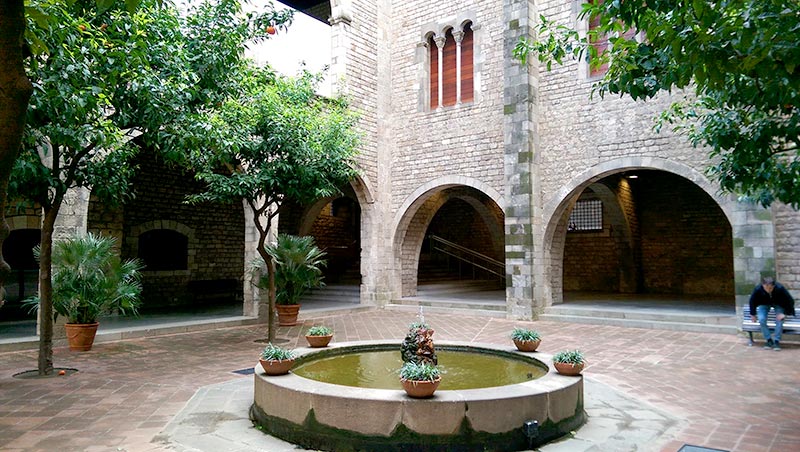
The Ancient Synagogue of Barcelona
In the gothic quarter, in the formerly Jewish quarter (the Call), lies the Ancient Synagogue, dedicated in the name of the Rashba. It is the oldest synagogue in Spain and one of the oldest in Europe (from around the third century). The synagogue, which was renovated and reopened, stands as a testament to the Jewish life lived there.
Today the synagogue functions as a museum. Daily tours take place in in English and in Spanish, Tuesday-Sunday, 11:00AM-2:30PM, 4:00PM-7:30PM.
The Call Museum (MUHBA EL CALL)
The Barcelona City History Museum “El Call” is situated right next to the Ancient Synagogue. The small museum is a branch of the Historic Museum of Barcelona, serving as one of its heritage sights, of sorts.
The Call was the quarter where Barcelona’s Jews lived in the past, and the museum depicts their dominance in the city’s history. The museum places an emphasis on the life and works of Rabbi Shlomo Ben Aderet (The Rashba), a native of the city who lived and operated in it.
Hours of admission: Sunday: 11:00AM-7:00PM; Wednesday, Friday, 11:00AM-2:00PM.
The Barcelona City History Museum (MUHBA)
If you have any time left, you could delve deeper into the city’s history at The Barcelona City History Museum. The museum resides in the former medieval royal palace. Here, the remains of the old Roman city that was excavated beneath the existing buildings, exhibits from the city’s tumultuous history, and video art can be seen.
pay attention to the Hebrew inscriptions on some of the walls, which were taken from the Jewish cemetery for construction purposes.
Tip: On Sundays after 15:00, admission to the museum is free of charge.
The Citadel Park – Parc de la Ciutadella
After exhausting ourselves wandering through the quarter’s alleyways, it is recommended to rest and relax at Ciutadela Park; a charming, green lung in the city center, east of the Gothic Quarter.
The park boasts an impressive fountain in its center, the work of several architects including Gaudí, who was only a student at the time of its construction. The fountain is surrounded by a pond, in which ducks leisurely swim alongside rowboats. Climbing up its steps to view the surrounding park is recommended.
Trees from all over the world, lawns, and statues dot the park’s grounds. In its center stands the citadel, now home to the Catalan Parliament. The city zoo is located at the park as well. Renting a bicycle and enjoying an hour’s workout riding throughout the park’s lanes is recommended.
The Triumphal Arch
A wide promenade begins at the edge of the park and ends at the triumphal arch. The impressive arch, made of red brick, was erected and put on display at the 1929 Universal Exhibition.
The Old Harbor – Port Vell
In the evening we’ll go out to the Old Harbor (Port Vell) to enjoy the view at sunset.
Day 2
On this day we will go to the “Mountain of the Jews” and to the Castle of Montjuïc and enjoy the spectacular city views. We will visit the interesting Spanish Village nearby, and if we’re into art, pop into the nearby Miró museum. In the evening we’ll go out to enjoy the beauty of España Square and the Venetian towers. We will watch the Magic Fountain’s show and the sight of the National Palace lit at night.
The Mountain of the Jews (MONTJUÏC)
“The Mountain of the Jews” is a Barcelona hill, named after the Jewish tradition of burying the dead outside the city walls. The Mountain of the Jews overlooks the city’s old harbor and is southwest of the city center.
On the southwest part of the hill lies Montjuïc Fortress (Castell de Montjuïc), erected in the 17th century. Despite the Fort’s dark past (it used to be a prison, and many executions were held in it) it is now an excellent place to enjoy a lovely view of the city and the Mediterranean Sea.
During the 30’s of the previous century the hill was selected to play host to the Barcelona Universal Exposition (1929), which included the erection of special sites atop it:
- The National Palace – (Palau Nacional) is built in the classical style, with Spanish renaissance influences. Waterfalls by the artist Carles buïgas adorn the steps leading to the palace, and 99 large spotlights illuminate the structure and the city skies. Today the place is home to the National Art Museum of Catalonia.
- The Olympic Stadium (Estadi Olímpic)
- The Magic Fountain – (Font Màgicaa)located at the feet of the Palau Nacional. The fountain’s exhibits include movie soundtracks, classical, and modern music, including Barcelona by the band Queen.
Tip: It is highly recommended to take the recently renovated cable car up the Mountain of the Jews and enjoy a high vantage panorama of the city.
The most convenient way to reach the cable car is to take the funicular from the Paral·lel metro station and take the 750-meter ride straight up to the hilltop. You can get on and off at each of the three stations: Montjuïc Park, Miramar, and Montjuïc Fort. Cable car tickets can be purchased here >
You can reach the hilltop by foot, using the escalator, or by cable car. I recommend the latter, and to proceed on foot from there.
The Spanish Village (POBLE ESPANYOL)
One of the most popular attractions at Montjuïc is the Spanish Village, built in 1929 for the Barcelona International Exposition. This is a street-shaped open-air museum featuring various styles of Spanish architecture. The architect who built the village traveled all over Spain and brought with him different models of homes from all over the country. “The Home of the Jew” is featured, among others.
Tip: The Spanish Village museum offers its visitors audio headphones in Hebrew too!
The Magic Fountain of Montjuïc (FONT MÀGICA DE MONTJUÏC)
No visit to Barcelona is complete without viewing the famous Magic Fountain at least once. Situated below the National Palace, the Magic Fountain was designed by Carles Buïgas and constructed with the aid of about 3,000 workers. An impressive avenue lined with smaller fountains leads to the Magic Fountain. Its magic lies in the spectacular combination of the water’s movement with the colorful lighting, synchronized with the music played. The performances start over every half hour, to different tunes.
Performance times: winter – Friday and Saturday 7:00PM- 8:30PM (the fountain is closed from January 6–February 16); summer – Thursday–Sunday 9:30PM–11:00PM.

Day 3
The first part of the day will be dedicated to the marvelous creations of gifted architect Antonio Gaudí in Barcelona. We will visit the amazing Park Güell, and then proceed to the Eixample District, where some of Gaudí’s prominent creations are: Casa Milà and Casa Batlló.
On the second part of the day we will visit a charming park on the city’s outskirts, “Labyrinth Park of Horta”.
Park Güell
Park Güell (Parc Güell) is a system designed and built by the architect Gaudí, who was assigned the task by his patron, Count Güell, in the early 20th century. The original plan was to erect a luxury housing project on the outskirts of Barcelona. The project failed since it was too far from the city, a deterrent for the city’s wealthy population at the time, and construction was halted before its completion. Gaudí managed to finish the entry gate to the complex, the municipal garden, and two example homes.
The area was abandoned for many years, until it was purchased by the Barcelona Municipality and turned into a public garden. The park was declared a UNESCO World Heritage Site in 2005.
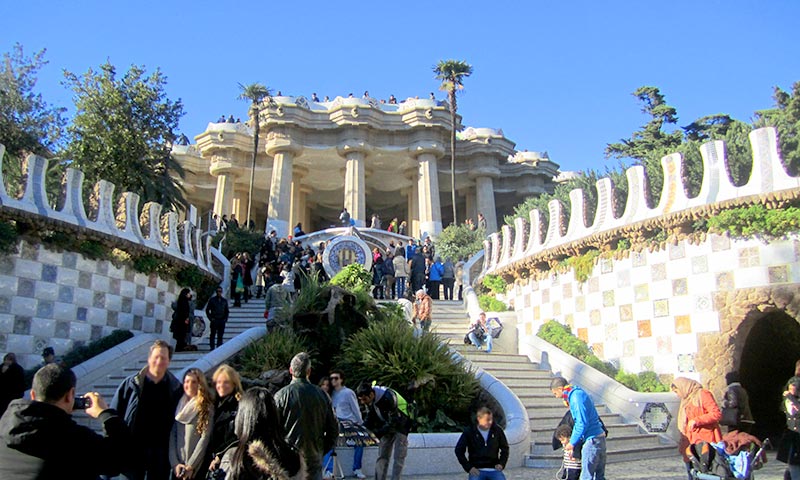
Gaudí allowed his imagination to run wild when designing the magical park, and visitors get a feeling of Alice in Wonderland; Every corner holds wonderous creations and surprises.
The green garden surrounding the park is free for visitors, and entry into the main part requires payment.
Tip: It is very important to purchase your tickets in advance (a day or two before your visit, and in the summer even earlier than that). The Park is very popular, and often there would be no available tickets to purchase on site. If any tickets remain, you will have to stand on a very long line.
Eixample District – The Expansion
Eixample (expansion) is a Barcelona district in the city’s center, between the old city and what were once surrounding small towns which later became its neighborhoods. The district was constructed in the late 19th century by industrialists and merchants during the prosperity of the Spanish middle class.
The neighborhood is characterized by many buildings, constructed in the Modernista style (the Catalan version of art nouveau). The most renowned of which were designed by Gaudí, including Casa Milà, Casa Balló, and the Sagrada Famíllia church, all declared as UNESCO World Heritage Sites.
The main streets in the district are Passeig de Gràcia, beginning at Plaça Catalunya, and Avinguda Diagonal – famous for its shopping centers and designer stores.
CASA MILÀ, The Stone Quarry
Casa Milà, popularly known as La Pedrera (the quarry) is a private residence built by Antoni Gaudí between 1906 – 1910. Commissioned by Pere Milà i Camps and named after him, the structure was named a national site and declared a World Heritage Site by UNESCO in 1984.
Gaudí designed the building in his typical style, mainly characterized by the absence of straight lines. The curving structure resembles ocean-waves, and is six story-high, surrounding two inner courtyards. The chimneys resemble the heads of warriors, clad in helmets.
Casa Balio (CASA BATLLÓ)
Casa Balio is a residential House renovated by Gaudi at the invitation of Jozef Bellio between 1904 and 1906.
Gaudi focused on renovating the facade of the building. He wanted to illuminate the first floor where the owners lived. To this end he added sandstone balconies from the front that had been brought from Montjuic. The unique shape of the balconies gave the building one of its nickname – “The Bone House” (Casa dels ossos).
The attic of the building was built in a curved shape resembling the shape of a dragon, which also gave the house the nickname “Dragon House”.
Park Labyrinth (Laberint d'Horta Park)
The Labyrinth Park is one of the most unique and magical parks in Barcelona. It is the oldest garden in Barcelona (from late 18th century) and is built in neo-classical style with Italian touches.

Do you also want to travel independently and kosher?
Join thousands of other travelers, and receive straight to the email the most comprehensive and practical articles for observant travelers abroad.
Sign up here:
מלונות כשרים בברצלונה בעברית: מלונות מתאימים לשומרי כשרות במרכז ברצלונה, מלונות ליד בית חב”ד ברצלונה ועוד תוכלו למצוא באתר מטיילים בכיפה

